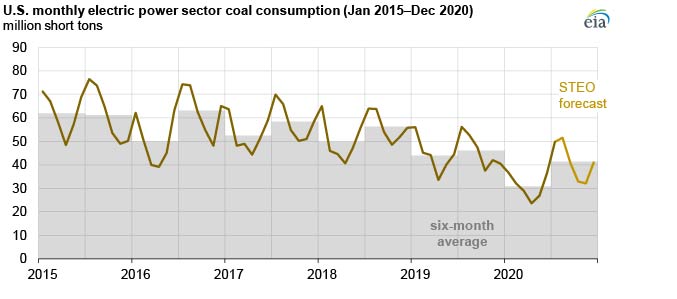
From January to June 2020, the electric power sector consumed 184.8 million short tons (MMst) of coal, 30% less than during the same period in 2019. After setting an annual record of 1,045 MMst in 2007, coal consumption in the electric power sector has been declining. This decline is happening as many coal-fired power plants are retiring or are converting to natural gas, driven by tighter air emission standards and the decreased cost-competitiveness of coal relative to other resources.
In addition to reduced coal-fired generation capacity, declines in electric power sector coal consumption so far in 2020 are partially a result of competition arising from low natural gas prices, which reached record lows at the U.S. Henry Hub benchmark in the first half of the year. Relatively mild winter temperatures and responses to the COVID-19 pandemic both reduced electricity demand. Lower demand also contributed to the decline in coal consumption for electric power in the first half of 2020.
In the U.S. Energy Information Administration’s (EIA) latest Short-Term Energy Outlook (STEO), EIA expects electric power coal consumption to increase in the second half of 2020, although not to the consumption levels seen in the second half of 2019. If the STEO forecast is realized, this year’s annual coal consumption level will be the power sector’s lowest level since 1975.

Coal consumption in other sectors is also declining. Coke plant coal consumption from January to July 2020 was 9.2 MMst, a 14% decrease compared with the same period in 2019. EIA expects coke plants to consume an additional 6.4 MMst in 2020. In that case, 2020 coke plant coal consumption will be 13% lower than 2019 levels.
Coal consumption in the retail and other industrial sector (which includes industries such as cement production and primary metal manufacturing) hit a record monthly low of 1.9 MMst in April 2020, when many business and manufacturing facilities began to shut down. From January through July, the retail and other industry sector consumed 14% less coal than during the same period last year.


Follow us on social media: